COVID “vaccination” has us (barely) living through a GLOBAL POPULATION CRASH
The authors of the ongoing democide believe that it will make the world a better place for THEM. We who really want the world to be a better place must stop them, break their power, and indict them.
“ABV” stands for “anything but the ‘vaccine.’” We use it to refer to articles whose authors strain to name some other “factors” causing this unprecedented cull..
What better way to preface this apocalyptic overview than to revisit Bill Gates’ (in)famous 2010 Ted Talk, in which he proposed “our” lowering the global population by “10 or 15%,” through “vaccines, health care [sic] and reproductive health services” (i.e., lots more abortions). He cast this project as an urgent one, because “CO2 is warming the planet.”
The segment with Gates making that “humanitarian” suggestion, as well as the whole talk, was on YouTube, which disappeared it early in the “COVID crisis.” So here’s Gates’ whole performance, still accessible on Rumble:

The video is also in this article, along with a full transcript:
Here’s the crucial bit:
First, we’ve got population. The world today has 6.8 billion people. That’s headed up to about nine billion. Now, if we do a really great job on new vaccines, health care, reproductive health services, we could lower that by, perhaps, 10 or 15 percent. But there, we see an increase of about 1.3.
Later, early in the COVID-19 panic, Gates, interviewed by Stephen Colbert, indiscreetly tipped his hand (and Colbert quickly urged him to use different wording, lest “the conspiracy theorists” seize on what Gates really said):
It now appears that Gates—and his towering cohorts in the eugenics movement (guided by the likes of David Rockefeller)—have got their wish; only Gates was shrewdly lying when he lowballed the number of those marked for non-existence. (The cantankerous Ted Turner, a eugenicist fanatic like Bill Gates, didn’t hesitate to come right out and say that 90% of the human race must go.) Thanks to them, and their multitudinous accessories, what we’re now living through (if we’re lucky) is a catastrophic global population crash—which will do, is now doing, vastly graver harm to all the rest of us than “overpopulation,” COVID and CO2 combined.
Brace yourself, and read the evidence; then do all you can to spread the word about this democide, and that it’s the responsibility of all who can still think to bring the authors of the most destructive crime in history, and all their accomplices, to justice.
World fertility rates in ‘unprecedented decline’, UN says
June 10, 2025
United Nations Population Fund [UNFPA] surveyed young adults and those past their reproductive years. “The world has begun an unprecedented decline in fertility rates,” says Dr Natalia Kanem, head of UNFPA. “Most people surveyed want two or more children. Fertility rates are falling in large part because many feel unable to create the families they want. And that is the real crisis,” she says. In all countries, 39% of people said financial limitations prevented them from having a child. The highest response was in Korea (58%), the lowest in Sweden (19%). In total, only 12% of people cited infertility – or difficulty conceiving – as a reason for not having the number of children they wanted to. But that figure was higher in countries including Thailand (19%), the US (16%), South Africa (15%), Nigeria (14%) and India (13%).
Japan Confirms Over 600,000 Citizens Killed by Covid ‘Vaccines’
September 21, 2025

Chilling news is emerging from Japan as the nation’s leading experts have uncovered explosive evidence linking skyrocketing excess deaths to Covid mRNA “vaccines.” A grassroots coalition, United Citizens for Stopping mRNA Vaccines, has forced the release of official vaccination records for 21 million Japanese citizens through a series of Freedom of Information Act (FOIA) requests. The records include vaccination dates, batch numbers, and post-vaccine death reports. The results are devastating.
Professor Murakami of Tokyo Science University, a respected scientist, analyzed the data and uncovered a consistent, alarming pattern:
• A surge in deaths occurred 90–120 days after injection.
• Those who received multiple doses saw earlier and steeper death spikes, suggesting cumulative toxicity.
• Murakami estimates that 600,000–610,000 Japanese citizens have been killed by the “vaccines.”
This figure is eerily consistent with Japan’s excess death statistics. Because these deaths typically happen months after the jab, doctors rarely connect them to the shots, allowing health officials to hide the carnage in plain sight.
Covid ‘Vaccines’ Triggered Global Turbo Cancer Crisis
September 24, 2025
Devastating alarm bells are emerging from Russia as the nation’s leading experts warn that chilling new evidence proves that the global turbo cancer crisis was caused by Covid mRNA “vaccines.” An alarming new review has confirmed the link between mass mRNA “vaccination” and skyrocketing cancer cases and deaths recorded around the world. The study was led by renowned Russian researcher Angelina Alekseevna Seliverstova and Dr. Oleg Germanovich Makeev, Professor of Biology and Biotechnology at Ural State Medical University in Yekaterinburg. Their findings confirm that the worldwide rollout of Covid mRNA shots triggered unexpected long-term safety risks. Most damning of all, the study exposes how Western institutions have downplayed, censored, or outright concealed these risks. The authors accuse global health officials of keeping the public in the dark about what could be the most devastating medical cover-up in modern history.
Unlike many Western studies, this review declared no financial conflicts of interest, no outside funding, and no pharmaceutical ties, underscoring the independence of its conclusions. The warning from Russia is clear, as the world is now grappling with a medical ticking time bomb unleashed by the mRNA experiment. Meanwhile, the establishment is doing everything it can to silence the truth.
The evidence is mounting and shows that mass mRNA “vaccination” has not only failed to stop Covid but may be fueling an ongoing surge in cancer, chronic illness, and unexplained deaths. The warnings from Russian and Western scientists now converge on a single reality, revealing that humanity has been subjected to a reckless experiment with catastrophic consequences. Yet, the cover-up may be as dangerous as the injections themselves.
UNITED STATES
US population decline sooner than expected as deaths to outpace births in America by 2031
September 19, 2025
The US population is approaching a critical demographic milestone as deaths are now projected to exceed births as early as 2031, two years earlier than previously expected. This shift signals a trend toward near-zero population growth, raising concerns about the country’s economic future and social support systems. In conclusion, the convergence of lower birth rates and aggressive immigration enforcement signals a turning point in U.S. demographic dynamics. Policymakers face the urgent task of addressing this population slowdown’s economic repercussions while balancing immigration regulations and social welfare needs.
Puerto Rico ranks among world’s fastest-shrinking populations
April 21, 2025
Puerto Rico is the fourth jurisdiction with the highest population decline in the world, according to recent statistics showing the island’s population shrank by 1.2% in 2024 compared to the previous year. The Cook Islands in the South Pacific, American Samoa, and Saint Pierre and Miquelon experienced greater population declines — at 2.24%, 1.54% and 1.21% respectively — Statista reported. Of the 20 countries with the highest rate of population decline, the majority are island nations, where emigration rates are high, particularly to Australia, New Zealand and the U.S. mainland, or they are in Eastern Europe, which suffers from a combination of high emigration and low birth rates, according to Statista. Puerto Rico’s population is forecast to decline steadily between 2024 and 2029, dropping by 100,000 people, or 3.13%, to little more than 3.1 million in 2029 — reaching its lowest level since 1977. The island’s population peaked at 3,827,000 in 2004, according to World Bank and U.S. Census Bureau data.
CANADA
ABV:
Canada’s population growth slows to historic lows as temporary residents decline
September 25, 2025
Canada’s population stood at an estimated 41.65 million on July 1, 2025, rising by just 47,098 people, or 0.1%, over the previous quarter. According to Statistics Canada, this is the lowest second-quarter growth rate since the onset of the COVID-19 pandemic in 2020, when border closures nearly halted migration. Excluding that year, it is the slowest pace for a second quarter since comparable records began in 1946. From July 2024 to July 2025, Canada’s population expanded by 389,324 people (+0.9%), sharply lower than the 1.21 million (+3.0%) added a year earlier. Much of the slowdown came after the federal government introduced policies in 2024 to reduce temporary migration.
MEXICO
ABV:
Birth rate in Mexico declines, mirroring a global phenomenon
October 2, 2024
Mexico’s birth rate fell to a three-year low in 2023, with 1.8 million births recorded, marking a significant decline in fertility, according to a report by the National Institute of Statistics and Geography. This decline will have important implications for the country’s labor market, healthcare, and economic growth, signaling an urgent need for policy adjustment to address the evolving demographic landscape. Several interconnected factors have contributed to the decline in birth rates, including rising living costs and economic pressures, as reported by Al Jazeera.
CUBA
ABV:
Cuba gets older: The island reports its lowest birth rate since the Revolution
March 10, 2025
A group of Cuban officials has confirmed what has been obvious on the streets of Cuba for some time: that the country has much fewer people than it did three years ago. Fewer births are being registered and only older adults are increasing as a demographic group. The latest official figures from the National Statistics and Information Office (ONEI) show that the latest exodus of Cubans has emptied the country out; that women are reluctant to have children in the midst of an endless economic crisis, and that young people are leaving while the elderly remain behind. Authorities have said that this population aging should not be “dramatized,” but researchers insist that it should not be underestimated either. In any case, they say that the problem is not aging per se, but the conditions in which Cubans are getting older.
BRAZIL
ABV:
Latin America’s Fertility Decline is Accelerating. No One’s Certain Why
January 5, 2024
Among demographers, 2023 will be remembered as the year Brazil “shrank” by almost 5 million people. A new census put the country’s population at 203 million people—well below the 208 million previously estimated by Brazil’s national statistics institute, and even further from the 216 million calculated by the United Nations. Those missing people didn’t vanish or emigrate—they were never born. The 2022 census, delayed by the COVID-19 pandemic, showed that Brazil’s population grew during the 2010s by just 0.52% per year—half the rate seen throughout the 2000s, and the lowest such percentage since 1872. Brazil is not alone. For half a century, fertility rates around the world have been drifting downwards thanks to a confluence of rising education levels, greater labor force participation by women, strengthened reproductive rights, and wider access to contraception. But in several Latin American and Caribbean countries, this decline has recently accelerated to an unexpected degree that even experts are struggling to explain.
UNITED KINGDOM
ABV:
Fertility rate hits record low in England, Scotland and Wales
August 27, 2025
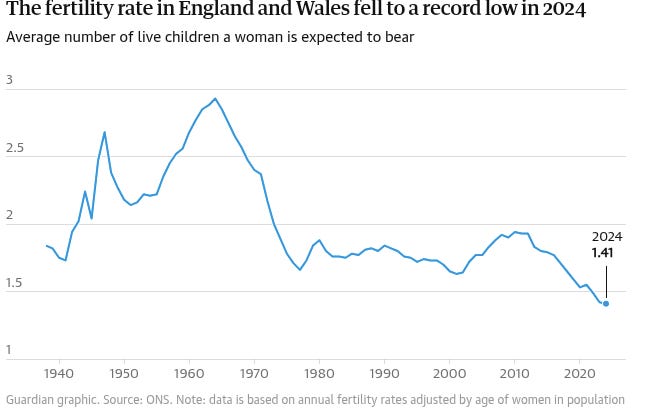
The fertility rate for England and Wales has fallen for the third year in a row to reach a record low, figures show. The total fertility rate across both countries, meaning the average number of live children women can expect to have across their child-bearing life, stood at 1.41 in 2024, down from 1.42 in 2023, the lowest since comparable data was first collected in 1938, according to the Office for National Statistics (ONS). This is despite a 0.6% increase in live births last year, with a 14% increase in the number of babies born to fathers over 60, according to figures published last month. Bernice Kuang, a demography researcher at the University of Southampton, said the fall in fertility rates could be a temporary result of people postponing having children.
FRANCE
ABV:
Birth rate in France: The decline under the microscope
July 10, 2025
The birth rate in France is declining, and the trend has been observed under the microscope by the Académie Nationale de Médecine and INED (French institute for demographic studies), which have each recently published a report on the subject. The decline recorded can be analysed through different factors. The total number of births has been steadily falling since 2010 in mainland France. At that date, the number of births was 832,000. In 2024, a historic low was recorded with 663,000 babies. To understand these figures, the post-war record was achieved in 1971 with 916,000 births. These raw figures should also be compared with the size of the population. Indeed, the size of the population bears an obvious link with the total number of births. The INSEE (National Institute for Statistics and Economic Studies) defines the birth rate as the number of births during the year relative to the total mean population for the year. The rate has been falling almost constantly for several decades. from 14.8 in 1982, it has dropped to 9.9 in 2023. Many analyses have been put forward in order to understand the phenomenon. Among the explanatory factors, the social and professional status of women is important. Women are undertaking longer studies, and a much higher proportion of women have a salaried income.
BELGIUM
After decades of growth, Brussels’ population is set to decline
June 20, 2025
The Brussels region is expected to see a slight population decline to just under 1.25 million by 2034 after two decades of steady growth, the Brussels Institute for Statistics and Analysis said in a new report. Between 2004 and 2024, the region’s population grew from 1 million to 1.25 million, with international migration being one of the main drivers. Non-Belgians accounted for 37.2% the population data from last year shows – the French are topping the list, followed by Romanians and Italians. But the next decade isn’t expected to see any further growth, as residents are leaving for other parts of the country and birth rates are declining. By 2034, the numbers are expected to drop to just under 1.25 million, the Brussels Institute for Statistics and Analysis (BISA) estimates in a new report. The municipalities of Brussels are projected to lose 2,400 inhabitants between 2024 and 2034.
GERMANY
Germany updates: Population growth on the decline
June 20, 2025
In 2024 Germany‘s population rose by 0.1% which is a drop from the 0.4% growth witnessed the year before, according to preliminary figures released by the Federal Statistical Office on Friday. As a result, the population for the EU’s largest economy now stands at 83.6 million. The figures showed that, as in previous years, more people died than were born in Germany, but the population growth came about due to immigration. Population growth concentrated in Germany’s western states, which saw an increase of 0.2%, while the eastern states, excluding the city-state of Berlin, recorded a decline of 0.3%. The largest increase for a state came in Bavaria, with population numbers up by 73,000. The biggest population losses occurred in the eastern states of Thuringia (down 15,000 or 0.7%), Saxony (down 12,000 or 0.3%), and Saxony-Anhalt (down 9,000 or 0.4%).
MOLDOVA
ABV:
A disappearing country. Moldova on the verge of a demographic catastrophe
August 1. 2025
Moldova is one of the fastest depopulating countries in the world. Since it gained independence in 1991, the population of its right-bank region (the territory controlled by Chișinău, excluding the separatist region of Transnistria) has shrunk by approximately 35%. This is primarily due to mass labour migration driven by economic conditions, involving over one million citizens of a country with a current population of 2.4 million. Other significant factors contributing to Moldova’s declining population include a dramatic drop in fertility rates and high mortality associated with low life expectancy, which is ten years below the EU average. Consequently, Moldovan society is ageing rapidly; in 1991, the average age of a resident was 29, compared to 38 at present.
CROATIA
ABV:
Can Croatia stop the population decline?
March 4 2025
Croatia is facing a serious depopulation crisis, with many young people leaving in search of better opportunities. In an effort to reverse this trend, the government has pledged €700 million in 2024 to support returning Croatians, tax relief, and affordable housing. But will these measures be enough to keep people in the country? Experts warn that financial incentives alone won’t solve the problem, HRT writes. The biggest challenge for young families remains securing a place to live. Croatia is implementing projects aimed at reducing the cost of housing construction, yet it still ranks among the most expensive EU countries in terms of property prices.
SERBIA
ABV:
No one left to live, let alone work: Serbia faces a major demographic crisis
June 23, 2025
The saying “The further south you go, the sadder it gets” perfectly applies to the story of demographic changes in certain parts of Serbia, which are now heavily influencing the labour market. In essence, in some regions, depopulation has reached alarming levels, threatening not only to reshape the local economy but also to alter the structure and even the nationality of the workforce. While this may sound overly pessimistic, data from both national and international institutions indicate that the country and its leadership face serious demographic challenges. If left unchecked, these challenges could significantly reshape the economy – not only in southern and eastern Serbia, where the problem is most pronounced – but in the entire country. The bleak reality is underscored by World Bank data, which ranks Serbia 13th globally for the fastest population decline. Jakup Berisha, UNDP’s Resident Representative in Serbia, also reminds us of this status. “The census shows that Serbia has 6.65 million inhabitants, 496,000 fewer than in 2011. Due to a low birth rate, an ageing workforce, and emigration, the number of young people entering the labour market is decreasing, while the number of pensioners is rising faster than we can replace outgoing workers. At the same time, emigration disproportionately draws away highly educated professionals, further worsening labour shortages in key industries,” Berisha told NIN.
BULGARIA
ABV:
Bulgaria Among EU’s Most Declining Populations as Demographic Shifts Intensify
August 7, 2025
Over the past two decades, Bulgarians rank among the top three populations in the European Union that have experienced significant decline. Across the EU, the share of children in the population has fallen, marriages are increasingly rare, and one in four newborns last year had a mother from an immigrant background. The latest European statistics shed light on these demographic trends. Eurostat data shows the EU population grew by 4% over 20 years, concentrated mainly in five countries: Germany, France, Italy, Spain, and Poland, which together account for nearly 70% of the total. Smaller populations include Malta, with around half a million inhabitants. Bulgaria’s population stands at approximately 6.4 million, placing it 15th in size among EU member states. Within this timeframe, 19 countries saw population growth while 8 experienced decline. Luxembourg’s population doubled, followed by Malta and Ireland, which increased by about one-third. Bulgaria saw a notable 17% reduction, equivalent to a loss of roughly 1.3 million people, second only to Latvia’s 18% decrease. Immigration remains a significant factor shaping the EU’s demographic landscape.
GREECE
ABV:
Greece announces €1.6bn relief package to tackle population decline
September 7, 2025
Greece has announced drastic measures, including tax breaks and other financial incentives, to address a population decline that is on course to make it the oldest nation in Europe. The prime minister said the €1.6bn (£1.4bn) relief package had been dictated by one of the biggest challenges facing the Mediterranean nation: a demographic crisis of unprecedented scale. Greece’s near decade-long crisis has been widely blamed for the alarming drop. This is partly because younger people were among those hardest hit by austerity measures required in return for international rescue funds that kept bankruptcy at bay and debt-stricken Athens in the EU.
ABV:
Low Birth Rates, Brain Drain, and Living Conditions Drive Greece’s Population Down by Half a Million
August 23. 2025
The latest report by the Laboratory of Demographic and Social Analyses of the University of Thessaly paints a grim picture of the current state and future demographic outlook of Greece, as the country’s population continues to age disproportionately and decline sharply. Data shows that the total population of Greece has declined by half a million over the last thirteen years, while the birth-death ratio is projected to remain negative until at least 2050, pointing towards a shift in the migratory flows balance as the most imminent solution to the problem. According to the report, the reasons for this significant decline in population are not only related to demography but more generally to the social challenges that Greece has faced in recent decades and the worsening living conditions for both native Greeks and migrants.
POLAND
Poland records EU’s largest population decline for second year running
July 15, 2025
Poland’s population fell by over 123,000 in 2024, the largest overall decline among all European Union member states for the second year in a row. In relative terms – taking account of the size of countries’ population – Poland had the EU’s joint-third-largest drop of 0.34%. The data for 2024 mark the sixth consecutive year that Poland’s population declined amid a demographic crisis that the country’s statistical agency has forecast will continue in the coming decades. Last year saw the number of births in Poland fall to a new postwar low. It was the 12th year in a row in which deaths have outnumbered births. Poland’s fertility rate – the average number of children that are born to a woman over her lifetime – also fell to a new record low of 1.099, which is among the lowest in the world.
CZECH REPUBLIC
Population Decline in the Czech Republic: 27,000 Fewer Residents in the First Half of 2025
September 11, 2025
The population of the Czech Republic decreased in the first half of 2025. By the end of June, 10.88 million people were living in the country, 27,200 fewer than at the start of the year. This is due to both the negative birth-to-death balance and emigration abroad. According to data from the Czech Statistical Office (ČSÚ), 57,700 people died in the first six months – almost 2,000 more than in the same period last year. In contrast, only 37,400 children were born, a decrease of around 12 per cent compared with the first half of 2024. Nearly half of all births occurred outside marriage, and most children were born to women aged 30 to 32.
ALBANIA
ABV:
Albania, with the strongest population decline in Europe in the last decade
July 14, 2025
Throughout Europe, especially in developing countries, people are moving in search of a better life. Globalization, the opening of markets, the easing of movement and work permit criteria by aging developed countries are opportunities that, naturally, many will try to take advantage of, especially young people who today have higher expectations from life. But no one is leaving at the rate that Albanians are leaving. The latest Eurostat data, processed by “Monitor”, show that Albania’s population has been reduced by 18.2% at the end of 2024, compared to 2011, a period that includes the development of two censuses. In Albania, the strong population contraction is related to two factors. First, the slowdown in natural increase, which turned negative during the pandemic and is now at minimal levels, with only 1.2 thousand people plus in 2024, from over 60 thousand people in the early 90s. The second and most important factor is emigration, which saw a new wave after 2016, mainly from the young population. In 2024, according to Eurostat, net emigration was 28.8 thousand people.
PORTUGAL
In six, months, 102 new cases of childhood cancer were reported in Ceara
September 23, 2025
The data are from the Albert Sabin Children’s Hosptial and refer to the number of visits performed in the state public health system in the first six months of 2025. [paywall]
Portugal grapples with accelerating demographic decline
August 28, 2025
Portugal is confronting a deepening demographic crisis, as recent data from the National Statistics Institute (INE) highlights a marked decline in its younger population and a significant increase in the elderly. The Portugal News reports that in 2023 only 12.8 percent of the Portuguese population was aged between 0 and 14, positioning the country as the third in the European Union with the lowest proportion of young people, surpassed only by Italy and Malta. This trend is attributed by the INE to decades of consistently low birth rates combined with a rise in life expectancy. Analysis reveals that between 1970 and 2024, the proportion of young people in Portugal decreased from 28.5 to 12.6 percent. The INE projects that if current demographic patterns persist, Portugal’s resident population will decline to approximately 8.2 million by 2080. This forecast further accentuates the urgency for policy interventions designed to stimulate birth rates and facilitate the integration of young people and migrants into the labour market.
ITALY
Italy’s demographic crisis worsens as births hit record low
March 31, 2025
Italy’s demographic crisis deepened in 2024 as the number of births hit a new record low, emigration accelerated and the population continued to shrink, national statistics bureau ISTAT said on Monday. Italy’s ever-falling birth rate is considered a national emergency, but despite Prime Minister Giorgia Meloni and her predecessors pledging to make it a priority, none have so far been able to halt the drop. There were some 281,000 more deaths than births in 2024 and the population fell by 37,000 to 58.93 million, continuing a decade-long trend. Since 2014, Italy’s population has shrunk by almost 1.9 million, more than the inhabitants of Milan, its second-largest city, or of the region of Calabria in the country’s southern toe. The 370,000 babies born in 2024 marked the 16th consecutive annual decline and was the lowest figure since the country’s unification in 1861. It was down 2.6% from 2023, ISTAT said, and 35.8% lower than in 2008 – the last year Italy saw an increase in the number of babies born. The fertility rate, measuring the average number of children born to each woman of child-bearing age, also fell to a record low of 1.18, far below the 2.1 needed for a steady population.
Unprecedented Crisis in Italy, Population Decreasing to 54,8 Million by 2050
April 1, 2025
Italy is facing an unprecedented demographic crisis that will have profound economic and social repercussions in the coming decades. According to data presented by the president of Istat, Francesco Maria Chelli, during the hearing at the Parliamentary Commission of Inquiry on the effects of the demographic transition, the Italian population continues to decline, reaching 58,9 million inhabitants in 2025, with a decrease of 37 thousand people compared to the previous year. The forecasts for the future are even more worrying: by 2050 the population will drop to 54,8 million, with a loss of over 4 million inhabitants compared to current levels.
TURKEY
ABV:
Turkey sounds alarm over declining birth rates amid economic concerns
May 27, 2025
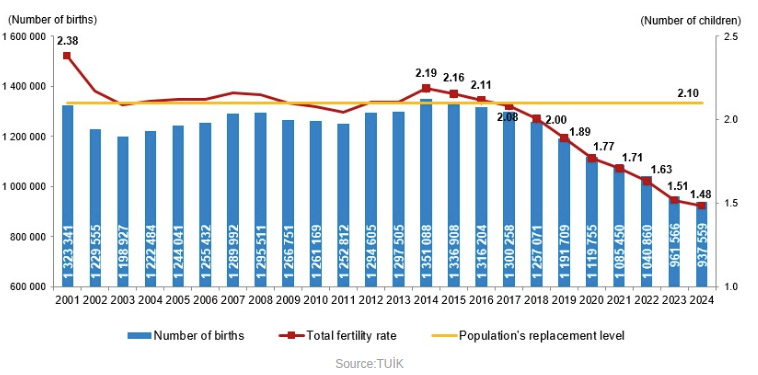
Turkey’s birth rate has plunged to its lowest level in modern history, prompting warnings from officials and experts, who say the country is facing a demographic crossroads. Recent data from the Turkish Statistical Institute (TÜİK) show that the total fertility rate in 2024 fell to 1.48 children per woman, well below the population replacement level of 2.1 and a steep decline from 2.38 in 2001. The number of live births in 2024 stood at 937,559, with boys accounting for 51.4 percent and girls for 48.6 percent. This marks a continuation of a trend that demographers and economists say is increasingly linked to economic hardship in Turkey, particularly among young adults of childbearing age.
IRAN
Iran’s Seemingly Unstoppable Birth Slump
May 21, 2025
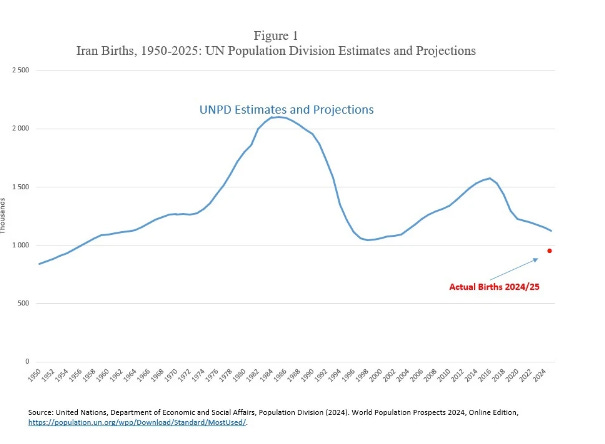
Despite exhortations from ruling clerisy to be fruitful, and pro-natal policies intended to prop up birth rates, fertility in Iran is slumping once again. Earlier this month, the Tehran Times reported that annual births in Iran fell below the million mark. According to the Civil Registration Organization in charge of Iran’s vital statistics, just under 980,000 births were recorded between the Iranian calendar year coinciding with 21 March 2024 through 20 March 2025. It has been a very long time since so few babies were born in Iran. By the reckoning of the United Nations Population Division, we have to go back seventy years—to 1955—to find a time when Iranian annual birth totals were lower than today. The current birth level, as we see in Figure 1, is less than half as high as it was forty years ago, in 1985.
SAUDI ARABIA
Grim warning: Writer warns of declining population in Saudi Arabia
February 8, 2025
A Saudi writer has raised alarms about the country’s declining birth rates, warning that Saudis could face extinction. In an article published in the Saudi newspaper Al Watan, Mansour Al Daban referenced UN data that shows a worrying drop in Saudi birth rates. The figures indicate that births in Saudi Arabia fell by 67 per cent in 2023 compared to 1950, when the birth rate was 53.34 per 1,000 people. By 2023, the rate had plummeted to 15.7, marking a 2.88 per cent decline from the previous year. Al Daban also cited a study titled Epidemiological Decline in Human Fertility Rate in the Arab World, conducted by researchers from the University of Sharjah in the UAE. The study, which analysed fertility rates in the Arab world from 2011 to 2021, found a similar decline in most Arab countries.
RUSSIA
Russia’s Birth Rate Plunges to 200-Year Low
April 14, 2025
Russia’s attempts to boost its flagging birth rate — through policies promoting “traditional values,” tighter abortion restrictions and officials’ encouragement of larger families — appear to be falling short, as the number of births has fallen to its lowest level in centuries. According to data released by the state statistics agency Rosstat, 195,400 children were born in Russia during January and February 2025 — a 3% drop compared to the same period in 2024. The decline was even steeper in February alone, with births falling 7.6% year-over-year to 90,500 — 7,400 fewer than in the same month last year. Some regions saw even sharper drops. Births fell by 18.7% in Arkhangelsk, 19.4% in the republic of Karelia, 18.6% in the Oryol region, 21.6% in Kostroma and 26.6% in Smolensk. According to demographer Alexei Raksha, the first quarter of 2025 likely saw the lowest number of births since the early 1800s, with February marking the lowest monthly figure in over 200 years. Based on preliminary registry office data, he estimated that 95,000 to 96,000 children were born in March, bringing the total for the first quarter to around 293,000-294,000.
INDIA
India Shuts Down Schools Over Birth Rate Decline
June 18, 2025
Some parts of India have been forced to shut down schools amid the country’s declining birth rates. Economist Sanjeev Sanyal, who was previously the principal economic adviser in India’s finance ministry and a member of the Economic Advisory Council to Indian Prime Minister Narendra Modi, has spoken about this happening and called for it to occur “more routinely.” “Our population is only growing now because we are living longer, we are not having enough babies,” he told the Indian financial newspaper Mint on Monday. “So our problem is already the case that in parts of the country we have to shut down schools.” “We should be shutting them down,” he added. “We are doing them slowly. But we need to do them more routinely. Because whenever I mention that we need to shut down schools, people get very emotional about this issue.”
THAILAND
ABV:
Rethinking Thailand’s Population Crisis through the Lens of a “Reluctant Economist”
September 23, 2025
Many of us are already aware of Thailand’s growing demographic crisis. The country is now experiencing “more deaths than births,” and the Thai population is steadily shrinking. Within approximately 50 years, the population is projected to drop by half—from over 60 million to just over 30 million. The country will be filled with elderly citizens. Working-age individuals will become rare, and the number of children and youth will decline dramatically. All of this stems from one key issue: Thai people are having fewer children. This is undeniably a major issue that many sectors are trying to address with the best possible solutions. In our article, “Integrated National Strategic Plan: Turning Thailand’s Population Crisis into Future Opportunities,” we presented macro-level strategies for dealing with this issue. However, in this article, we want to invite everyone to “rethink” the problem through the perspective of the “Reluctant Economist”—a concept developed by Professor Richard A. Easterlin. This lens, which is rarely seen (or perhaps never seen) in Thai discourse, may help us better understand the root cause of the population crisis—and possibly lead us to better solutions. Thailand’s declining birth rate poses the core of the population crisis. From the perspective of the Reluctant Economist, the central question is, why are people choosing to have fewer children? [Hint – It’s not lower fertility.]
VIETNAM
Why Vietnam’s Demographic Decline Will Reinforce Its Non-Aligned Foreign Policy
August 26, 2025
Demographic decline is causing multiple headaches for Vietnamese policymakers. According to the latest statistics, Vietnam’s births per woman in 2024 declined to 1.91 from 1.96 in 2023, which is slightly below the replacement rate of 2.1. Vietnam’s population is aging rapidly. The number of people over the age of 60 increased from 11.4 million in 2019 to 14.2 million in 2024 out of a population of approximately 100 million. This cohort is projected to reach 18 million in 2030. An aging population and a declining workforce will put pressure on Vietnam’s nascent welfare system and its ambitious growth target of becoming a high-income country by the 2040s. The Communist Party of Vietnam (CPV) is encouraging births by handing out a one-time cash payment to women having two newborns before the age of 35 and not punishing party members who have a third child. This year, Vietnam also ended its two-child policy and allowed families to decide for themselves how many children they can have.
CHINA
Chinese kindergartens in crisis as enrolments plunge 25% in 4 years
July 26, 2025

The number of Chinese kindergartens has fallen by a quarter in four years, prompting the closure of tens of thousands of schools in the country as a precipitous drop in births hits the education system. Enrolments in China’s kindergartens have declined by 12mn children between 2020 and 2024, from a peak of 48mn, according to data from the country’s ministry of education. The number of kindergartens, serving Chinese children aged 3-5, has also fallen by 41,500 from a high of nearly 295,000 in 2021. Falling enrolments are now “baked into the system and that’s not going to change”, said Stuart Gietel-Basten, director of the Center for Aging Science at the Hong Kong University of Science and Technology. He added that compared with five or 10 years ago, the decline in births was “huge”. The contraction of China’s pre-school system is a foretaste of the challenges to come for business and policymakers from China’s demographic decline, which is expected to be one of the most rapid in the world. China has recorded three consecutive years of population decline to 2024 following the decades-long policy, ended in 2016, that limited many couples to one child. While the number of births rose by about 520,000 last year to 9.3mn, following a record low in 2023, they were still outpaced by deaths and have declined by nearly half since the peak of 17.9mn in 2017.
ABV:
China to offer $500 per child in move to boost birth rate
July 28, 2025
The Chinese government will offer parents subsidies of 3,600 yuan ($500, €429) per child under the age of three per year, Beijing’s state media said Monday. China‘s population has declined for three consecutive years, the world’s second most populous nation — after India — is facing an emerging demographic crisis. The number of births in 2024 — 9.54 million — was half as many as in 2016, the year that ended its one-child policy that was in place for more than three decades. Marriage rates in China have also hit a record low. Young couples put off having babies due to the high cost of raising children and career concerns.
ABV:
China’s population falls for a third consecutive year
January 17, 2025
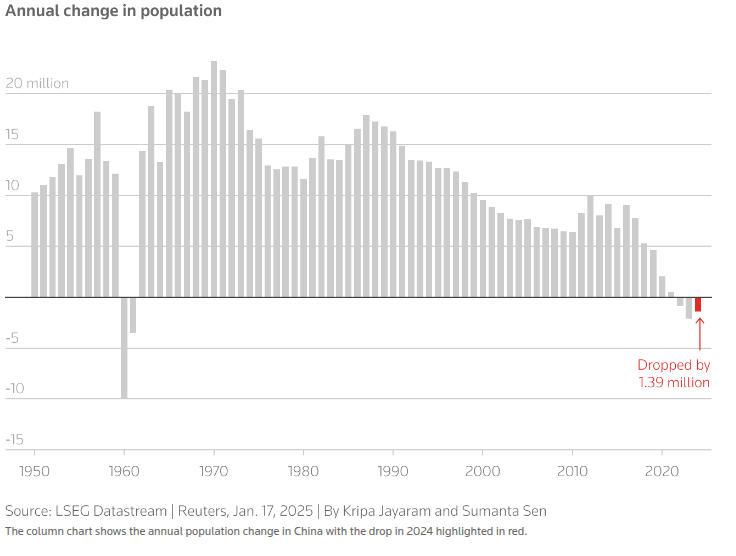
China’s population fell for a third consecutive year in 2024, with the number of deaths outpacing a slight increase in births, and experts cautioning that the trend will accelerate in the coming years. The National Bureau of Statistics said the total number of people in China dropped by 1.39 million to 1.408 billion in 2024, compared to 1.409 billion in 2023. Friday’s data reinforces concerns that the world’s second largest economy will struggle as the number of workers and consumers declines. Rising costs from elderly care and retirement benefits are also likely to create additional strains for already indebted local governments. The high cost of childcare and education as well as job uncertainty and a slowing economy have also discouraged many young Chinese from getting married and starting a family. Gender discrimination and traditional expectations for women to take care of the home exacerbate the issue, demographers say.
TAIWAN
Taiwan sees 18th consecutive month of population decline
July 10, 2025
Taiwan’s population declined for the 18th consecutive month as of the end of June, according to data released Thursday by the Ministry of the Interior (MOI). In total, 55,375 babies were born in the first half of 2025, down 8,499 from the same period last year, when 63,874 births were recorded. Meanwhile, 16,554 deaths were reported in June, equivalent to approximately one death every 2.6 minutes. That figure represents an increase of 1,172 from May and 1,632 more than in June 2024. The crude death rate for the month stood at 8.63 per 1,000 people. The natural population decrease – the difference between births and deaths – was 7,586 for June.
SOUTH KOREA
ABV:
New South Korea Data Reveals Scale of Population Decline
September 5, 2025
Marriages in South Korea have dropped by nearly half over the past three decades, while annual births have fallen to just one-third of 1995 levels, according to newly released data. The numbers show what officials consider a looming population crisis. South Korea‘s fertility rate—the lowest in the world—stood at 0.75 births per woman in 2024, well below the 2.1 needed to sustain a population. The same year, the share of South Koreans aged 65 and older passed 20 percent. The demographic shift could drag on the country’s economic prospects and strain its pension and health care systems, with fewer young workers supporting a growing elderly population. Analysts have cited high housing costs, an unforgiving workplace culture and unequal burdens of child care as key reasons young South Koreans are deciding to delay or forgo children.
South Korea’s Military Personnel Plummet 31% as Male 20s Drop 16%
September 23, 2025
This year, the male population in their 20s stood at approximately 3,024,000, a 15.8% decrease compared to the male population in their 20s in 2010, 15 years ago. Meanwhile, South Korea’s military personnel, which numbered 650,000 (based on the Defense White Paper) in 2010, plummeted to 450,000 over 15 years, a 30.7% drop. The reduction in military personnel has outpaced the natural decline in the population eligible for service. Analysis suggests that populist policies aimed at shortening military service periods to appeal to younger voters have accelerated the military’s crisis more rapidly than the decline in conscription resources due to low birth rates.
THE PHILIPPINES
Philippine population growth slowing down
July 17, 2025
The Philippines’ annual population growth rate (PGR) is declining, according to data from the Philippine Statistics Authority (PSA). President Ferdinand Marcos Jr. has officially declared the country’s latest population count at 112,729,484, based on recent data. This marks an increase of 3.69 million people since the last nationwide census in 2020, when the population stood at 109.03 million.
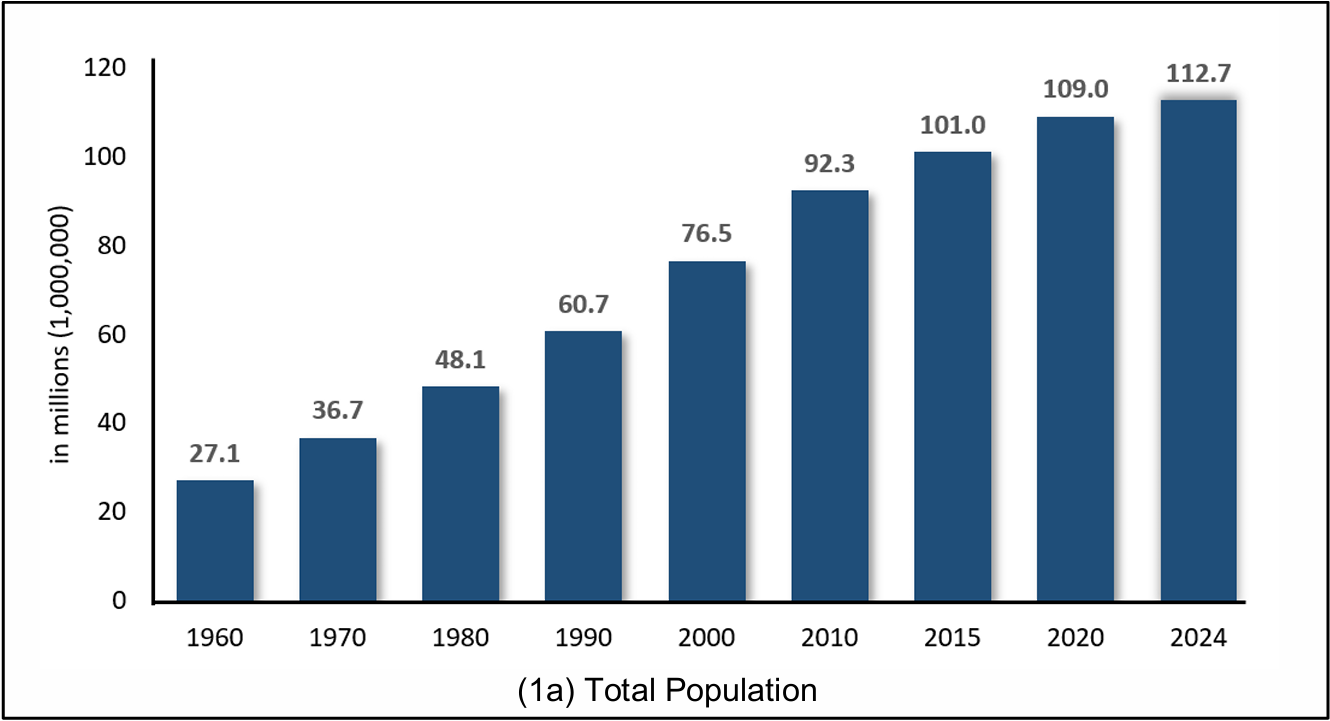
A table showing the increase in the Philippines’ population since 1960
The population and the population growth rate (PGR) are two different things. The population refers to the total number of people, while the PGR measures the rate at which that number increases over time. Despite an increase in the overall population size, the PGR has declined, from 1.63% between 2015 and 2020, to 0.80% between 2020 and 2024. The country’s PGR has been generally declining since 1960 to 1970, when it was recorded at 3.01%.
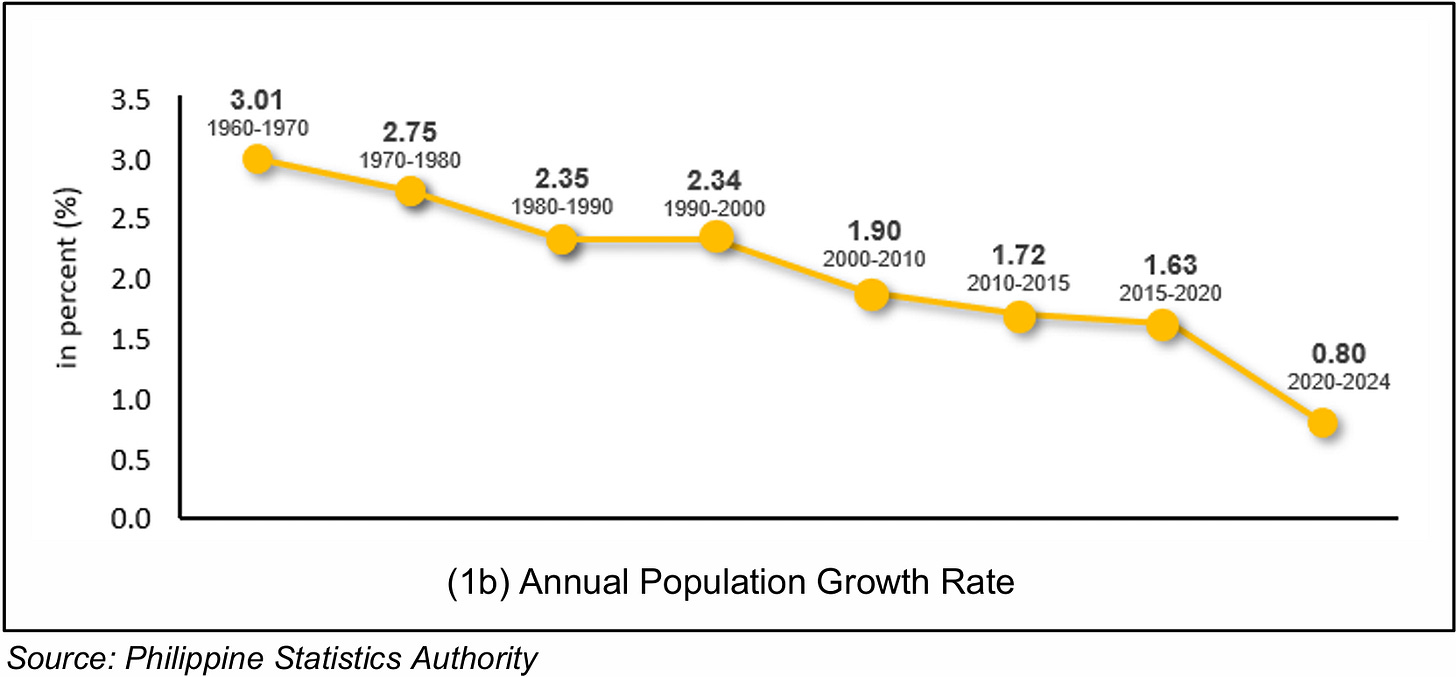
A table showing the decline in the Philippines’ population growth rate since 1960
“The slowdown in the growth rate may be driven by several interrelated factors such as but not limited to declining fertility and birth rate, elevated mortality during the COVID-19 pandemic, and subdued migration activity,” the PSA said.
AUSTRALIA
ABV:
Australia’s birth rate hits rock bottom with severe consequences for economic future
October 16, 2024
There are warnings that Australia’s birth rate — having hit a record low — is now at a critical level. Bureau of Statistics figures show 286,998 births were registered in Australia in 2023, resulting in a total fertility rate of 1.50 babies per woman. Australian National University demographer Liz Allen said the nation’s birth rate is perilously low. “We’ve hit rock bottom,” she said. The Total Fertility Rate, or TFR, over the past 30 years has slowly dropped from 1.86 in 1993 to 1.5 in 2023. The birth rate for girls and women aged 15 to 19 has fallen by more than two thirds over that period. There’s also been a large decline for women aged 20 to 24 years. She described a “deep-seated attitudinal problem” facing millions of younger Australians. Many, the demographer said, lack enthusiasm about the future, and that relates to their views on climate change, housing affordability and gender equality.
NEW ZEALAND
ABV:
New Zealand’s fertility rate hits record low as births fall
February 19, 2025
New Zealand’s fertility rate slumped to a record low in 2023, official data shows, as the total number of births also dropped. The fertility rate tracks the average number of births women will have in their lifetime. New Zealand, along with many countries around the world, has seen this number drop as factors like education, participation in the workforce, and access to contraception contribute to women having fewer children. Statistics NZ data released on Monday found there were 1,932 fewer babies born in the year ending December 2023 than in the year before, the lowest number of registered births in 20 years. The drop was despite a 3% increase in the number of women between 15 and 49 years old, the ages at which most children are born. The combination of fewer births and more women in the population led to the fertility rate hitting a record low of 1.56 births per woman. In 2022, the rate was 1.66, and it remains far below the 2.1 needed to replace population numbers in the long term.
From marksripsinmiller.substack
Disclaimer: We at Prepare for Change (PFC) bring you information that is not offered by the mainstream news, and therefore may seem controversial. The opinions, views, statements, and/or information we present are not necessarily promoted, endorsed, espoused, or agreed to by Prepare for Change, its leadership Council, members, those who work with PFC, or those who read its content. However, they are hopefully provocative. Please use discernment! Use logical thinking, your own intuition and your own connection with Source, Spirit and Natural Laws to help you determine what is true and what is not. By sharing information and seeding dialogue, it is our goal to raise consciousness and awareness of higher truths to free us from enslavement of the matrix in this material realm.
 EN
EN FR
FR





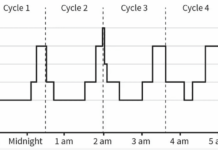



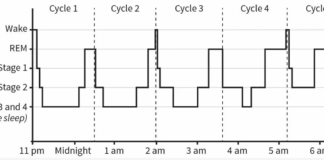

















time to change a fading bulb, remove the process that created this mess and bet the world will change so rapidly we might even understand we have a Secret Space Program and there are other rocks out there to play nice man evolving by without corruption and tyranny shake a little oppression by and note these old crabby politics do not work.
never have never will. Corruption be-seeks corruption.
Time for Change
Time for The Light to shine in
Time for Love
Time all governments are removed
Time for all Borders be Removed
Time for all Lies'n'poisons erased and left alone.
Love of Life
Love of True Freedom
'given at birth' yet a tear in any eye seeing its beauty can smile at the real thing an call it "The Real Deal".
too hard to keep repeating. Enough is a Enough!